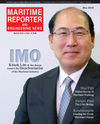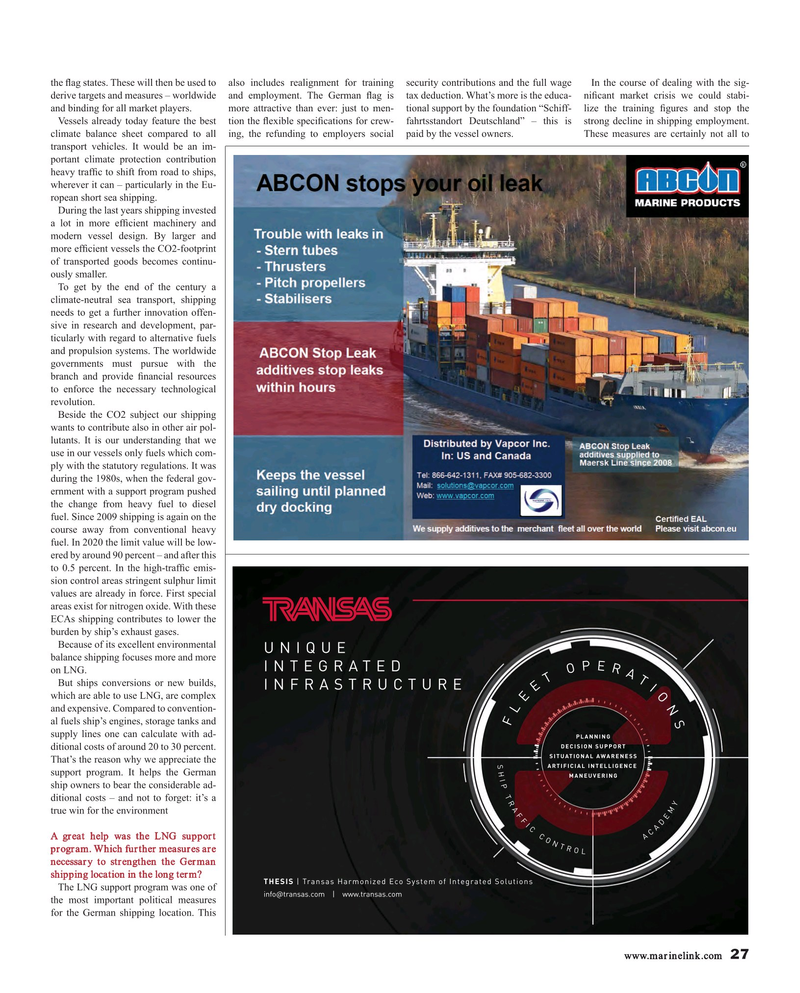
Page 27: of Maritime Reporter Magazine (May 2018)
Marine Propulsion Edition
Read this page in Pdf, Flash or Html5 edition of May 2018 Maritime Reporter Magazine
the ? ag states. These will then be used to also includes realignment for training security contributions and the full wage In the course of dealing with the sig- derive targets and measures – worldwide and employment. The German ? ag is tax deduction. What’s more is the educa- ni? cant market crisis we could stabi- and binding for all market players. more attractive than ever: just to men- tional support by the foundation “Schiff- lize the training ? gures and stop the
Vessels already today feature the best tion the ? exible speci? cations for crew- fahrtsstandort Deutschland” – this is strong decline in shipping employment. climate balance sheet compared to all ing, the refunding to employers social paid by the vessel owners. These measures are certainly not all to transport vehicles. It would be an im- portant climate protection contribution heavy traf? c to shift from road to ships, wherever it can – particularly in the Eu- ropean short sea shipping.
During the last years shipping invested a lot in more ef? cient machinery and modern vessel design. By larger and more ef? cient vessels the CO2-footprint of transported goods becomes continu- ously smaller.
To get by the end of the century a climate-neutral sea transport, shipping needs to get a further innovation offen- sive in research and development, par- ticularly with regard to alternative fuels and propulsion systems. The worldwide governments must pursue with the branch and provide ? nancial resources to enforce the necessary technological revolution.
Beside the CO2 subject our shipping wants to contribute also in other air pol- lutants. It is our understanding that we use in our vessels only fuels which com- ply with the statutory regulations. It was during the 1980s, when the federal gov- ernment with a support program pushed the change from heavy fuel to diesel fuel. Since 2009 shipping is again on the course away from conventional heavy fuel. In 2020 the limit value will be low- ered by around 90 percent – and after this to 0.5 percent. In the high-traf? c emis- sion control areas stringent sulphur limit values are already in force. First special areas exist for nitrogen oxide. With these
ECAs shipping contributes to lower the burden by ship’s exhaust gases.
Because of its excellent environmental
UNIQUE balance shipping focuses more and more
E
P
INTEGRATED
R on LNG.
O
A
T
T
But ships conversions or new builds,
INFRASTRUCTURE
I
E
O which are able to use LNG, are complex
E
N and expensive. Compared to convention-
L
S al fuels ship’s engines, storage tanks and
F supply lines one can calculate with ad-
PLANNING
DECISION SUPPORT ditional costs of around 20 to 30 percent.
SITUATIONAL AWARENESS
That’s the reason why we appreciate the
S
ARTIFICIAL INTELLIGENCE
H support program. It helps the German
MANEUVERING
I P T ship owners to bear the considerable ad- ditional costs – and not to forget: it’s a
R
Y
A true win for the environment
M
F
E
F I C C
D
A
C
A great help was the LNG support
A
O
N
T
R program. Which further measures are
O
L necessary to strengthen the German shipping location in the long term?
THESIS | Transas Harmonized Eco System of Integrated Solutions
The LNG support program was one of [email protected] | www.transas.com the most important political measures for the German shipping location. This www.marinelink.com 27
MR #5 (26-33).indd 27 MR #5 (26-33).indd 27 5/3/2018 10:59:23 AM5/3/2018 10:59:23 AM

 26
26

 28
28
